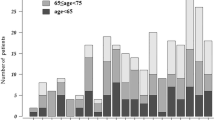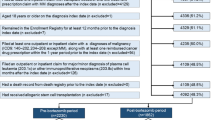Abstract
This is the first multicenter study from Pakistan exploring the prevalence, clinical presentations and treatment outcomes of Multiple Myeloma patients. This retrospective study involved data collection from hospital record system of four tertiary care referral hospitals of Pakistan including all patients diagnosed as having Multiple Myeloma from January 2014 to December 2018. The demographic details, clinical presentations, laboratory findings, treatment responses, and mortalities were evaluated. The progression-free survival and overall survival were analyzed considering relapse and mortality as the end points, respectively. For the progression-free survival, the Kaplan–Meier survival analysis and the log rank test were used to compare the survival function for chemotherapy followed by autologous stem cell transplant (ASCT) as opposed to chemotherapy alone (non-ASCT). The overall survival analysis was assessed by Kaplan–Meier survival analysis. This study identified 403 Multiple Myeloma patients in five years. The median age at presentation was 55 years. Bortezomib based drug regimens were the most commonly used initial treatments (57.5%). Forty three patients received ASCT. The progression-free survival median for ASCT and non-ASCT patients were 50 months (95% CI, 42–57.9 months) and 26 months (95% CI, 21.5–30.5 months), respectively. The cumulative probability of survival rate at 60 months was 80%. This study identified 403 Multiple Myeloma patients over 5 years in four tertiary care hospitals of Pakistan. It underscores the importance of autologous stem cell transplant in Myeloma patients and advocates improving its facilities in Pakistan.



Similar content being viewed by others
Data Availability
Will be available on request.
References
SEER Cancer stat fact sheets: myeloma (2021) National Institutes of Health, National Cancer Institute Surveillance, Epidemiology, and End Results Program. Available from URL: http://seer.cancer.gov/statfacts/html/mulmy.html. Accessed 20 Mar 2021
Cowan AJ, Allen C, Barac A et al (2018) Global burden of multiple myeloma: a systematic analysis for the global burden of disease study 2016. JAMA Oncol 4:1221–1227
Sonneveld P, Avet-Loiseau H, Lonial S et al (2016) Treatment of multiple myeloma with high-risk cytogenetics: a consensus of the International Myeloma Working Group. Blood 127(24):2955–2962
Lei M, Kim EB, Branagan A, Lou U, Zemel M, Raje N (2019) Current management and emerging treatment strategies for multiple myeloma. Rinsho Ketsueki 60(9):1243–1256. https://doi.org/10.11406/rinketsu.60.1243
Coriu D, Dytfeld D, Niepel D, Spicka I, Markuljak I, Mihaylov G, Ostojic-Kolonic S, Fink L, Toka KS, Björklöf K (2018) Real-world multiple myeloma management practice patterns and outcomes in selected Central and Eastern European countries. Pol Arch Intern Med 128(9):500–511. https://doi.org/10.20452/pamw.4305.Erratum.In:PolArchInternMed.2018Dec12;:null
Gratwohl A, Pasquini MC, Aljurf M, et al. (2015) One million stem-cell transplants: a retrospective observational study. Lancet Haematol. Published online February 27, 2015. https://doi.org/10.1016/S2352-3026(15)00028-9
Cancer Registry - Pakistan Health Research Council (2020) Available from URL: phrc.org.pk › cancer-registry. Accessed 10 Dec 2020.
Punjab Cancer Registry (2020) Available from URL: http://punjabcancerregistry.org.pk/index.php. Accessed 10 Dec 2020
International Association of Cancer Registries-Karachi Cancer Registry (2020) Available from URL: http://www.iacr.com.fr/index.php?option=com_comprofiler&task=userprofile&user=1214&Itemid=498. Accessed 10 Dec 2020
Masood A, Masood K, Hussain M et al (2018) Thirty years cancer incidence data for Lahore, Pakistan: trends and patterns 1984–2014. Asian Pac J Cancer Prev 19:709–717
Mahmood S, Faraz R, Yousaf A, et al. (2020) Annual Cancer Registry Report-2016, of the Shaukat Khanum Memorial Hospital and Research Center, Pakistan. Available from URL: http://shaukatkhanum.org.pk/wp-content/uploads/2015/06/acrr-2016.pdf. Accessed 30 Dec 2020
Rajkumar SV, Dimopoulos MA, Palumbo A, et al. (2014) International Myeloma Working Group updated criteria for the diagnosis of multiple myeloma. Lancet Oncol. Published online October 26, 2014. https://doi.org/10.1016/S1470-2045(14)70442-5
Durie BG, Harousseau JL, Miguel JS et al (2006) International uniform response criteria for multiple myeloma. Leukemia 20(9):1467–1473. https://doi.org/10.1038/sj.leu.2404284.Erratum.In:Leukemia.2007May;21(5):1134
Kumar S, Paiva B, Anderson KC, et al. (2016) International Myeloma working group consensus criteria for response and minimal residual disease assessment in multiple myeloma. Lancet Oncol. Published online August 01, 2016. https://doi.org/10.1016/S1470-2045(16)30206-6
Greipp PR, San Miguel J, Durie BG et al (2005) International staging system for multiple myeloma. J ClinOncol 23:3412–3420
International Agency for Research on Cancer (2021) WHO. Available from URL: https://gco.iarc.fr/today/data/factsheets/populations/586-pakistan-fact-sheets.pdf. Accessed 10 Mar 2021.
Zahid MF, Ali N, Nasir M et al (2019) Infections in patients with multiple myeloma treated with conventional chemotherapy: a single-center, 10-year experience in Pakistan. Hematol Transfus Cell Ther 41:292–297. https://doi.org/10.1016/j.htct.2019.02.005
Sultan S, Irfan SM, Parveen S, Ali H, Basharat M (2016) Multiple myeloma: a retrospective analysis of 61 patients from a tertiary care center. Asian Pac J Cancer Prev 17:1833–1835. https://doi.org/10.7314/apjcp.2016.17.4.1833
Hameed A, Ali J, Munawar K, Arshad F, Badar F, Siddiqui N (2018) Characteristics and outcomes of patients with multiple myeloma: Data from a developing country. Med J Islam Repub Iran 32:1. https://doi.org/10.14196/mjiri.32.1
Bora K (2019) Distribution of multiple myeloma in India: Heterogeneity in incidence across age, sex and geography. Cancer Epidemiol 59:215–220. https://doi.org/10.1016/j.canep.2019.02.010
de Moraes Hungria VT, Martínez-Baños DM, Peñafiel CR et al (2020) Multiple myeloma treatment patterns and clinical outcomes in the Latin America Haemato-Oncology (HOLA) Observational Study, 2008–2016. Br J Haematol 188(3):383–393. https://doi.org/10.1111/bjh.16124
Turesson I, Velez R, Kristinsson SY, Landgren O (2010) Patterns of multiple myeloma during the past 5 decades: stable incidence rates for all age groups in the population but rapidly changing age distribution in the clinic. Mayo Clin Proc 85(3):225–230. https://doi.org/10.4065/mcp.2009.0426
Nwabuko OC, Igbigbi EE, Okoh DA (2015) Plasma cell myeloma: Challenges in diagnosis in sub-Saharan Africa. Jokull Journal 65(1):254–266
Kumar L, Ramavath D, Kataria B et al (2019) For AIIMS Myeloma Group. High-dose chemotherapy followed by autologous stem cell transplant for multiple myeloma: predictors of long-term outcome. Indian J Med Res 149(6):730–739. https://doi.org/10.4103/ijmr.IJMR_1593_18
Al Hamed R, Bazarbachi AH, Malard F et al (2019) Current status of autologous stem cell transplantation for multiple myeloma. Blood Cancer J 9:44. https://doi.org/10.1038/s41408-019-0205-9
Munker R, Shi R, Nair B et al (2016) The Shreveport myeloma experience: survival, risk factors and other malignancies in the age of stem cell transplantation. Acta Haematol 135:146–155. https://doi.org/10.1159/000440970
Sonneveld P, Schmidt-Wolf IG, van der Holt B, et al. (2012) Bortezomib induction and maintenance treatment in patients with newly diagnosed multiple myeloma: results of the randomized phase III HOVON-65/ GMMG-HD4 trial. J Clin Oncol 30(24):2946–55. https://doi.org/10.1200/JCO.2011.39.6820. Erratum in: J Clin Oncol. 2012 Oct 10;30(29):3654
Sonneveld P, Goldschmidt H, Rosiñol L et al (2013) Bortezomib-based versus non bortezomib-based induction treatment before autologous stem-cell transplantation in patients with previously untreated multiple myeloma: a meta-analysis of phase III randomized, controlled trials. J Clin Oncol 31(26):3279–3287. https://doi.org/10.1200/JCO.2012.48.4626
Ali N, Adil SN, Shaikh MU (2015) Autologous hematopoietic stem cell transplantation-10 years of data from a developing country. Stem Cells Transl Med 4:873–877. https://doi.org/10.5966/sctm.2015-0015
Zaidi U, Shamsi TS, Farzana T et al (2019) Capacity building of stem cell transplantation facilities in Pakistan: joint efforts of NIBD, government, and private-sector institutions. Blood Adv 3(Suppl 1):41–44. https://doi.org/10.1182/bloodadvances.2019GS121552
Gill A, Gosain R, Bhandari S, Gosain R, Gill G, Abraham J, Miller K (2018) “Lost to Follow-up” among adult cancer survivors. Am J Clin Oncol 41(10):1024–1027. https://doi.org/10.1097/COC.0000000000000408
ACTION Study Group (2017) Health-related quality of life and psychological distress among cancer survivors in Southeast Asia: results from a longitudinal study in eight low- and middle-income countries. BMC Med 15(1):10. https://doi.org/10.1186/s12916-016-0768-2
Funding
None.
Author information
Authors and Affiliations
Contributions
Substantial contributions to conception and development of methodology and acquisition of data: All authors. Analysis and interpretation of data NS, DHK, MAM. Drafting the article: NS, MM, MAM. Revising it critically for important intellectual content: All authors. Final approval of the version to be published: All authors. Agreement to be accountable for all aspects of the work: All authors. Supervision: MAM.
Corresponding author
Ethics declarations
Conflicts of interest
All the authors declares that they have no conflicts of interest.
Ethics Approval
Taken from all hospitals.
Additional information
Publisher's Note
Springer Nature remains neutral with regard to jurisdictional claims in published maps and institutional affiliations.
Rights and permissions
About this article
Cite this article
Saeed, N., Ahmad, U., Moosajee, M. et al. A Multicenter Study of Clinical Presentations and Outcomes of Multiple Myeloma in Pakistan: The Real-World Analysis in a Resource-Constrained Country. Indian J Hematol Blood Transfus 38, 309–318 (2022). https://doi.org/10.1007/s12288-021-01485-y
Received:
Accepted:
Published:
Issue Date:
DOI: https://doi.org/10.1007/s12288-021-01485-y




